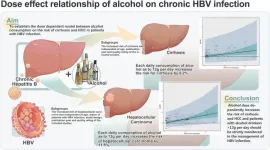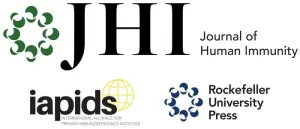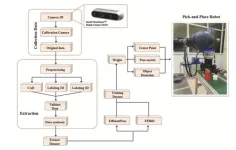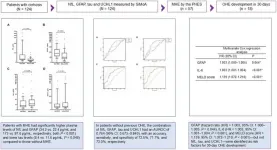(Press-News.org) COLUMBUS, Ohio – Young nearsighted kids who wear bifocal contact lenses that slow uncoordinated eye growth do not lose the benefits of the treatment once they stop wearing the lenses, new research shows.
The study is a follow-up to a clinical trial published in 2020 showing that soft multifocal contact lenses with a heavy dose of added reading power dramatically slowed further progression of myopia in kids as young as 7 years old. Researchers wondered if discontinuing that treatment might cause a rebound of faster-than-normal eye growth that wipes out the benefit.
In the new trial, nearsighted kids wore high-add bifocal lenses for two years followed by one year with single-vision contact lenses. Results showed no evidence that the treatment effect declined, and myopia progression then continued at age-expected rates.
“We want doctors to understand that you don’t lose the benefits that you gain with this treatment,” said senior author Jeffrey Walline, professor of optometry at The Ohio State University and chair of the project, known as the BLINK (Bifocal Lenses in Nearsighted Kids) Study.
“But more importantly, what we want to do with this research is give patients healthier eyes at a lower cost with more options. And then in adulthood, we want them to be able to function fully and with clear vision.”
The new follow-up study, known as BLINK2, is published today (Jan. 16, 2025) in JAMA Ophthalmology. Both trials were conducted at Ohio State and the University of Houston.
In nearsightedness, or myopia, the eye grows and is stretched into an elongated shape. This abnormality increases the risk for cataracts, detached retina, glaucoma and myopic macular degeneration, all of which can lead to loss of vision, even when wearing glasses or contact lenses.
Myopia is also common, affecting at least one-third of adults in the United States, and is becoming more prevalent – because, the scientific community believes, children are spending less time outdoors now than in the past. Nearsightedness tends to begin between the ages of 8 and 10 and progresses up to about age 18, when the eye might continue to grow but not become more myopic in most people.
Multifocal contact lenses for nearsighted patients correct for clear distance vision and include focal power that allows middle-aged eyes to read near work clearly.
In the original study, 294 nearsighted children aged 7-11 years were randomized into one of three groups of contact-lens wearers. Those who wore the lenses with the highest added power, 2.50 diopters, had shorter eyes and slower rates of myopia progression than the kids in the other two groups after three years.
Of the original participants, 248 continued in BLINK2, during which all – then aged 11 to 17 years – wore the high-add lenses for two years followed by single-vision contact lenses for the third year, a method used to see if the benefit remained after discontinuing the bifocal treatment.
At the end of BLINK2, eye growth returned to age-expected rates and there were no signs of faster-than-normal eye growth. Participants who had been in the original BLINK high-add group continued to have shorter eyes and less myopia at the end of BLINK2, meaning those who started high-add bifocal lenses in BLINK2 did not catch up to those who received the treatment when they were younger.
“After the children discontinue using the contact lenses, their myopia progression increases, but just to normal standards you would expect if you hadn’t treated them. And that happens no matter what age they are when they stop wearing the bifocal lenses,” said Walline, also acting dean in Ohio State’s College of Optometry.
This research and other studies have led to advances in the treatment landscape for nearsighted children: Options include multifocal contact lenses, contact lenses that reshape the cornea during sleep called orthokeratology, and atropine eye drops.
“This is a burgeoning area,” Walline said. “The standard of care has switched from providing kids with single-vision glasses or contact lenses to things that slow down the progression of myopia, or the growth of the eye.”
Walline and his colleagues are now pursuing funding for a clinical trial to see if it’s possible to delay the onset of myopia in young children by administering atropine eye drops before nearsightedness is detectable.
“What we know is that the earlier you become myopic, the more myopia you’re expected to have as an adult. So if we can delay the onset, then we can make a big difference,” he said.
BLINK was funded by the National Institutes of Health’s National Eye Institute and supported by Bausch + Lomb, which provided contact lens solutions.
David Berntsen, Golden-Golden Professor and chair of clinical sciences at the University of Houston College of Optometry, was the first author of this study. Additional co-authors were Anita Tićak and Amber Gaume Giannoni of the University of Houston, and Danielle Orr, Loraine Sinnott, Donald Mutti and Lisa Jones-Jordan of Ohio State.
#
Contact: Jeffrey Walline, Walline.1@osu.edu
Written by Emily Caldwell, Caldwell.151@osu.edu; 614-292-8152
END
Background and Aims
The quantitative effects of alcohol consumption on cirrhosis and hepatocellular carcinoma (HCC) in hepatitis B virus (HBV) infection are unknown. This study aimed to establish a dose-dependent model of alcohol consumption on the risks of cirrhosis and HCC.
Methods
PubMed, Embase, the Cochrane Library, Web of Science, and four Chinese databases were searched for studies published from their inception to 15 May 2024. A random-effects model was used to pool the data on the incidence of cirrhosis and HCC, and a dose-dependent model of alcohol’s effect on cirrhosis and HCC was established.
Results
A total of 33,272 HBV patients ...
January 16, 2025 – New York, NY – The International Alliance for Primary Immunodeficiency Societies (IAPIDS) and Rockefeller University Press (RUP) have entered a partnership to launch Journal of Human Immunity (JHI), the official open access journal of IAPIDS. This collaboration will ensure that JHI emerges as the destination for exciting research into human immunity, with a particular focus on inborn errors of immunity.
“The Journal of Human Immunity represents a bold step forward in advancing ...
Digital Science is pleased to announce that Dr Raym Crow, a leading figure in mission-driven, sustainable open publishing models, has won the 2025 APE Award for Innovation in Scholarly Communication.
The award – a joint initiative between Digital Science and the Berlin Institute for Scholarly Publishing (BISP) – has been announced at the 20th Academic Publishing in Europe (APE) Conference in Berlin, Germany.
The APE award is presented to an individual who has brought innovation in scholarly communication to the community, through infrastructure, technology, business models, output on the topic, theory, or practice.
With more than ...
Accurate object pose estimation refers to the ability of a robot to determine both the position and orientation of an object. It is essential for robotics, especially in pick-and-place tasks, which are crucial in industries such as manufacturing and logistics. As robots are increasingly tasked with complex operations, their ability to precisely determine the six degrees of freedom (6D pose) of objects, position, and orientation, becomes critical. This ability ensures that robots can interact with objects in a reliable and safe manner. However, despite advancements in deep learning, the performance of 6D pose estimation algorithms largely depends ...
Background and Aims
The performance of neurodegenerative biomarkers—neurofilament light chain (NfL), glial fibrillary acidic protein (GFAP), tau, and ubiquitin carboxy-terminal hydrolase L1 (UCHL1)—in diagnosing minimal hepatic encephalopathy (MHE) has not been systematically evaluated, simultaneously, nor have their associations with the development of overt hepatic encephalopathy (OHE). This study aimed to evaluate the performance of plasma NfL, GFAP, tau, and UCHL1 in diagnosing MHE and predicting the development of OHE in Chinese patients with hepatic cirrhosis.
Methods
In this prospective study, 124 patients ...
The remains of nearly 200 animals found in Mexico’s Teotihuacán are helping reconstruct history.
The unearthing and significance of these remains, found in four chambers within the Moon Pyramid — dating back nearly 2,000 years — are central in Nawa Sugiyama’s new book, “Animal Matter: Ritual, Place, and Sovereignty at the Moon Pyramid of Teotihuacan,” published by Oxford University Press.
Teotihuacán, one of the first megacities of the Western Hemisphere and now a UNESCO World Heritage site, is situated ...
New research forthcoming in Social Psychological and Personality Science illuminates why liberals and conservatives often support different types of leaders. The study shows that these preferences stem from differences in moral priorities rather than mere partisan bias.
"This research helps explain why people across the political spectrum often support such different types of leaders," explains lead researcher Harrison Miller, of Florida State University. "Rather than simply attributing these differences to political bias, ...
WASHINGTON -- If you’ve ever wondered whether your parents secretly had a favorite child, they might have. Parents may be more inclined to confer the “favorite child award” to daughters and children who are agreeable and conscientious, according to research published by the American Psychological Association.
“For decades, researchers have known that differential treatment from parents can have lasting consequences for children,” said lead author Alexander Jensen, PhD, an associate professor at Brigham Young University. “This study helps us understand which children are more likely to be on the receiving end of favoritism, which can ...
Ecological warning lights have blinked on across the Arctic over the last 40 years, according to new research, and many of the fastest-changing areas are clustered in Siberia, the Canadian Northwest Territories, and Alaska. The analysis of the rapidly warming Arctic-boreal region, published in Geophysical Research Letters this week, provides a zoomed-in picture of ecosystems experiencing some of the fastest and most extreme climate changes on Earth.
Many of the most climate-stressed areas featured permafrost, or ground that stays frozen year-round, and experienced both severe warming and drying ...
Wearable devices can identify, differentiate, and predict flare-ups, or the worsening of symptoms and inflammation, in inflammatory bowel disease (IBD), Mount Sinai researchers have shown in a first-of-its-kind study.
The findings, published in the journal Gastroenterology on January 16, suggest that wearable technology can predict the subsequent development of flares in IBD, enabling continuous disease monitoring through widely available commercial devices.
“Current disease-monitoring methods rely on patients directly interacting with ...






